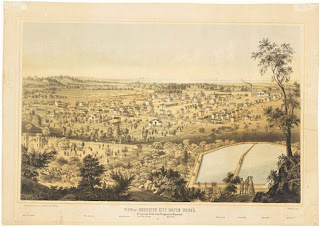Mt. Loretto was the site of an orphanage and farm founded by Father Drumgoole, the unofficial patron saint of homeless children and newsboys, in 1882.

From MIV Mt.Loretto: " In June 1882, six months after establishing the MIV in downtown Manhattan, he purchased the 400-acre country place and a large beach area off Raritan Bay on the Southern tip of Staten Island, called Mount Loretto. The mission was able to care for more than 2,000 homeless and destitute children annually. In the period from 1871 to 1885, the mission had cared for 15,730 children.The kids made their own clothes and shoes, grew their own food, and raised livestock and poultry. The home was completely free of debt.
Mount Loretto was cultivated into the most productive farm on SI, the largest in the state and the 3rd largest in the country. At peak production, 1,000 quarts of milk were produced daily. The barn, reputed to be the largest in the country, housed 300 head of cattle and 50 horses, the pen kept 600 pigs. The dairy farm, the 3rd largest in NYS, was closed and the herd was sold in 1961.

For more info:
http://www.dec.ny.gov/outdoor/8291.html

From MIV Mt.Loretto: " In June 1882, six months after establishing the MIV in downtown Manhattan, he purchased the 400-acre country place and a large beach area off Raritan Bay on the Southern tip of Staten Island, called Mount Loretto. The mission was able to care for more than 2,000 homeless and destitute children annually. In the period from 1871 to 1885, the mission had cared for 15,730 children.The kids made their own clothes and shoes, grew their own food, and raised livestock and poultry. The home was completely free of debt.
Mount Loretto was cultivated into the most productive farm on SI, the largest in the state and the 3rd largest in the country. At peak production, 1,000 quarts of milk were produced daily. The barn, reputed to be the largest in the country, housed 300 head of cattle and 50 horses, the pen kept 600 pigs. The dairy farm, the 3rd largest in NYS, was closed and the herd was sold in 1961.
Mount Loretto has the last undeveloped shoreline in the state, encompassing one mile of seashore. The property is an ecologically rich area of meadows, woodlands, wetlands, coastal bluffs, and shoreline. The "Mount" property, which has been fallow for 4 decades, is valued at more than $40 million."
The area is now under the auspices of the NYS Dept. of Environmental Conservation
 |
| A new private road to the remaining buildings |
 |
| the church was completed in 1891 |
A shrine overlooking Princes Bay: according to the plaque it was erected in 1935 by Katherine and Helen Tracy as a memorial to their brothers, apparently it's become a memorial to the more recently departed as well.

Makeshift shrines on the beach below
 | ||||
| The beach, the sculptures and the only red clay bluffs in the NYC area |
http://www.dec.ny.gov/outdoor/8291.html
Lemon Creek Park:
The park is just east of Mt.Loretto.
Lemon Creek is fed from a watershed that begins two and a half miles from the creek. The water travels over and under ground which carries it down to Princes Bay. A freshwater pond, only 100 feet from Raritan Bay, is adjacent to the marina and to the only purple martin colony in New York City.
 |
| The beach |

















































